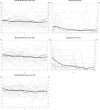Music Interventions in Hyperacute and Acute Stroke Patients: A Randomized Controlled Pilot Feasibility Study
- PMID: 40033585
- PMCID: PMC12093327
- DOI: 10.1002/acn3.70024
Music Interventions in Hyperacute and Acute Stroke Patients: A Randomized Controlled Pilot Feasibility Study
Abstract
Objective: Music interventions have been shown to have beneficial effects on hemodynamic parameters, pain, and anxiety in various medical settings. However, music interventions in the setting of acute stroke have not been studied. The objective of this trial was to perform a pilot feasibility study of music interventions in the setting of acute stroke to inform a larger efficacy trial.
Methods: Open label parallel group, randomized controlled trial with objective endpoints.
Results: The percentage of eligible patients approached for consent who were recruited into the trial was 85.7% (95% CI 75.9%-98%; 30/35) and the percentage of eligible patients recruited into the trial was 66.7% (95% CI 52.9%-80.4%; 30/45). Twenty-nine participants completed the first 6 h of the trial 96.7% (95% CI 82.8%-99.9%, 29/30). Participants were highly supportive of music interventions in the target setting (mean value of 8 (SD ± 1.6) on a scale of 1-10). 95% Confidence Intervals for efficacy included clinically important differences. Specifically, the SBPV was non-significantly lower in the intervention arm (mean difference - 1.31 mmHg, [95% CI -4.8 to 2.2 mmHg]). Similarly, the adjusted β was non-significantly lower in the intervention arm for change in pain burden (-3.9 [95% CI -11.4 to 3.7]) and change in anxiety burden (-9.9 [-98.2 to 78.5]).
Interpretation: Our findings support a larger trial of music or sound interventions in hyperacute and acute stroke patients as alternatives to or synergists with pharmacologic management.
Keywords: arterial pressure; complimentary therapies; music therapy; stroke.
© 2025 The Author(s). Annals of Clinical and Translational Neurology published by Wiley Periodicals LLC on behalf of American Neurological Association.
Conflict of interest statement
The authors declare no conflicts of interest.
Figures



References
-
- Mofredj A., Alaya S., Tassaioust K., Bahloul H., and Mrabet A., “Music Therapy, a Review of the Potential Therapeutic Benefits for the Critically Ill,” Journal of Critical Care 35 (2016): 195–199. - PubMed
-
- Dileo P. and Demetri G. D., “Update on New Diagnostic and Therapeutic Approaches for Sarcomas,” Clinical Advances in Hematology & Oncology 3 (2005): 781–791. - PubMed
-
- Dileo C., “Effects of Music and Music Therapy on Medical Patients: A Meta‐Analysis of the Research and Implications for the Future,” Journal of the Society for Integrative Oncology 4 (2006): 67–70. - PubMed
-
- Wong H. L., Lopez‐Nahas V., and Molassiotis A., “Effects of Music Therapy on Anxiety in Ventilator‐Dependent Patients,” Heart & Lung: The Journal of Critical Care 30 (2001): 376–387. - PubMed
Publication types
MeSH terms
LinkOut - more resources
Full Text Sources
Medical

